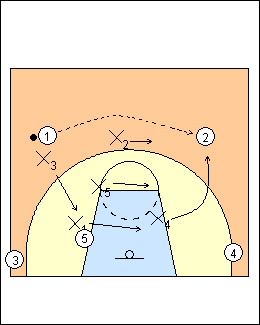1-3-1 extended DeChellis
 | 1 Ed DeChellis The extended 1-3-1 burns prep time for the other team, makes an athletic team less athletic, changes tempo quickly, and can neutralize a good post player since most teams use a 2-1-2, getting him away from the basket. It is high-risk, high-reward, can't be used for 40 minutes, rebounding is a problem (long shots mean long rebounds), and gives up corner jumpers. X2 is crafty, athletic, and can finish at the other end. He picks up the ball at halfcourt, pushes it to one side, will spin off and go under any ballscreen. X3 is a 3-man (long), covering wing to block. X4 is the best rebounder, most teams are right-handed. Wings X3 and X4 are on a string. X5 is the linebacker of the defence, able to stop penetration. He has his toes on the arc, but will drop down a step or two if there are two low-post attackers, and there should be heat on the ball (cover two high posts with X5 and a wing). X1 is probably the smallest defender, a point-guard type, athletic and fast to cover corner to corner, and a communicator because all the action is in front of him. He is always ballside. In transition after a missed shot, X1 is back to protect the basket, the wings sprint back wide to prevent passes up the sideline (they are interchangeable), X5 gets back to the top of the key, X2 sprints to halfcourt and finds the ball. DeChellis was scared to transition back into a 1-3-1, or any zone. For a herding drill, have O1 play against X2, X5 and X3, trying to drive a seam on the dribble (then go 4 on 5, with no post attacker, crack a seam or skip it). DeChellis hasn't seen a 1-4 high entry set, but might bring up the weakside wing. He has used the 1-3-1 on a sideline but not a baseline out of bounds. |
 | 2 There is always ball pressure when the ballhandler has his dribble; if he picks it up, get back in the passing lane. Pressure comes from the point or the wing, if the wing pressures, the point backs off in between the ball and the next offensive player. X1 is yelling at the wing to retreat or attack. Apply fake pressure, make teams feel like they are going to be trapped. Against a great point guard, fake at him and retreat, play with him. With the ball on the wing, X4 covers the weakside block and has his ballside (left) foot up in a boxer stance to see attackers on the weakside with peripheral vision. X5 keeps the ball out of the high post (X1 tells him to take a high post), but if there is no attacking high post, he can drop back a step or two to help the point guard on the low post. Usually front the post unless you want the ball in there. Never allow a direct pass, stay between the ball and the next attacker, hands up to force a pass overhead. Defenders have to have "bounce", they can't play flat-footed. Sprint when the ball is in the air. If 1 shoots, whoever is pressuring the ball blocks him out, X4 has to get the weakside blocked out, X2 or X5 has to block out the high post. |
 | 3 On a pass to the corner, X5 sprints down to cover the ballside block and can't let the ball go into the post. X3 faces the ball between the ball and the next offensive player, does not allow a direct pass back out (if there is a pass to 1, X3 pushes the ball away from the scoring area, then retreats). X4 reads the passer and looks to steal a skip pass. If 5 upscreens X5 coming down on a pass to the corner and 4 comes across looking for a pass, X4 has to come with him (there aren't many plays against 1-3-1, this is one). |
 | 4 Trapping the corner, X4 takes away the high post, X2 takes away a pass to 1. They don't trap on the wing. |
 | 5 On ball reversal, wing X4 comes out wide, no direct pass to the corner, pushes the ball out. |
 | Against an overload, X3 can't pressure the ball, X2 does. X3 plays in front of 2, he can't let the ball get there. X1 communicates this (attack or retreat). |